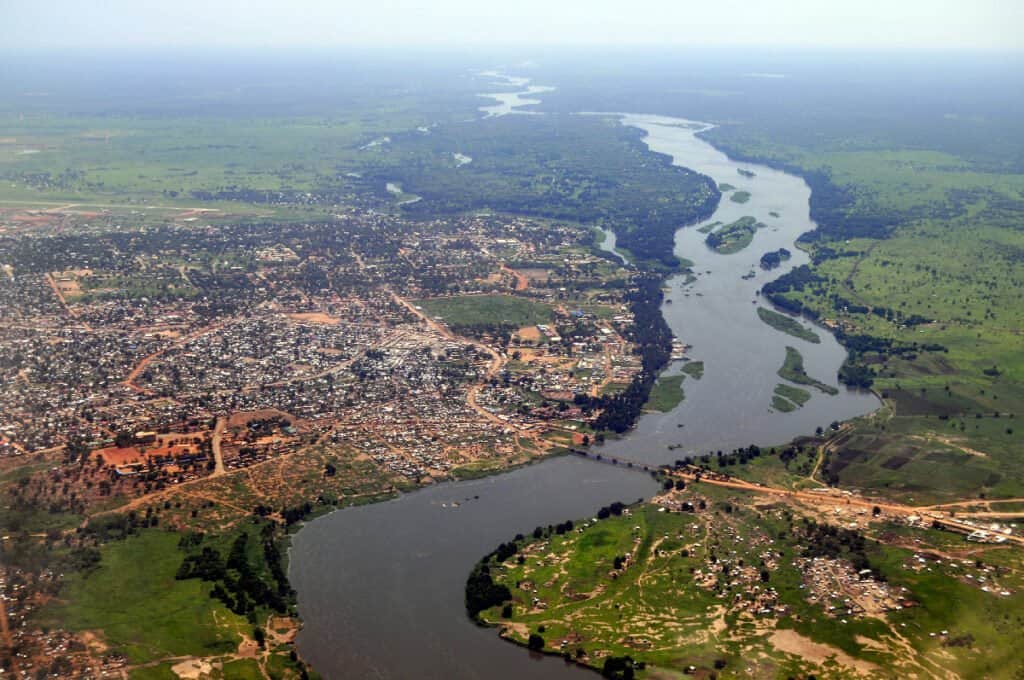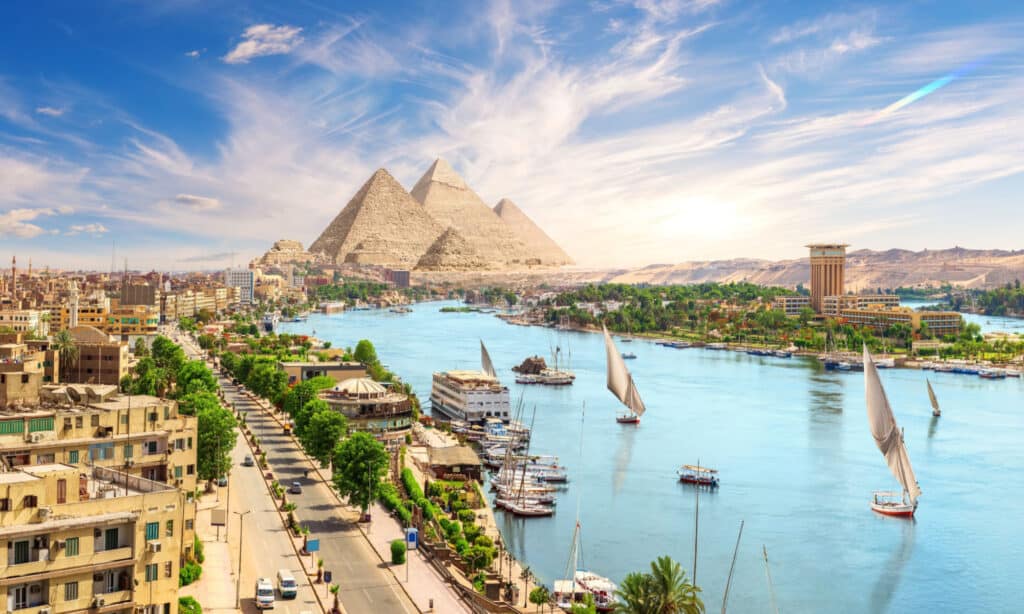The Nile River is famous for supporting the Ancient Egyptians and allowing them to flourish and come up with many advancements that were important to human development. To this day, Egyptians still celebrate the flooding of the Nile with an annual two-week holiday called Wafaa El-Nil. However, due to modern dams, the river no longer floods.
Why Did the Nile River Flood Each Year?
Every year, a monsoon hits the Ethiopian Highlands between May and August. Monsoon season typically includes heavy rains. These rains flow down through tributaries of the Nile River, the Blue Nile, the White Nile, the Sobat River, and the Black Nile. Residents call the Black Nile the Atbarah River. The Nile starts to rise in June and reaches its highest point in October. Then, it recedes until the cycle repeats itself the following June.
The first signs of the flood happened in Aswan, a city up the river, south of Cairo, towards Sudan. By September, Cairo flooded too, an area near the river’s delta where it opens into the Mediterranean Sea.

In ancient times, the annual flooding of the Nile River made the surrounding farmland more fertile.
©iStock.com/Phototreat
Were Ancient Nile River Floods Good?
In general, yes. In ancient Egypt, the Nile River’s reliable yearly flooding allowed for agriculture to take hold. Early residents of the area just used the fertile flooded areas for farming. However, about 7,000 years ago, Egyptians started to use floods to their advantage. They created a network of dikes, dams, and canals to divert the flood waters to fields. They would trap water in the area for about 6 weeks, then release it. The flood waters would deposit dark, nutrient-rich silt, and the water would make the soil more fertile. Once they released the water, they would start planting their crops and harvest them 3-4 months later depending on the crop. They were only able to grow their crops during the short time after the floods when the soil was still rich.
However, this system was rather fragile. If there was a year with a weaker flood, the water would not reach all the fields. If there was a year with a stronger flood, it would destroy some of the irrigation infrastructure. Even though it was a delicate system, without the yearly floods, the region may not have been able to support agriculture for between two and 12 million people living in the area.
Ancient Egyptians revered and appreciated the floods. Egyptians used something called a Nilometer to measure the floods each year. These devices were simple. They were a pillar, series of steps, or stone slab in the water. They were marked in cubits, a measurement that is no longer used in our modern world. Cubits could be broken down into smaller units for even more accuracy. Using these tools, Ancient Egyptians could track the flooding and predict the success of the following growing season.
They also had a lot of lore surrounding the floods. The star we now call Sirius was then associated with the Egyptian god Osiris. This star would emerge around the time of the floods, which is why Osiris is not only a god of death but also a god of renewal and fertility. The star also connected to Sodpet, a goddess of flooding and fertility.

Today, the Nile River doesn’t flood annually, thanks to the Aswan High Dam of 1970.
©AlexAnton/Shutterstock.com
Does Egypt Still Have Floods?
By the 1800s, the irrigation infrastructure from Ancient Egypt had greatly deteriorated. During this time, Muhammad Ali Pasha, Khedive (similar to a Sultan) of Egypt, implemented a new irrigation system that would allow for year-round water supply to fields. Over the late 1800s and early 1900s, the British colonists of Egypt built several dams on tributaries to the Nile to alleviate flooding during the wet season. However, most of these plans failed until the creation of the Aswan High Dam in 1970, implemented by Egyptian President Gamal Abdel Nasser Hussein. This dam has the power to contain the highest flood waters of the Nile, pooling them into Lake Nasser, one of the biggest man-made lakes in the world. On the Sudanese side of the lake, the lake is called Lake Nubia.
Though the Nile River no longer floods, the levels of the lake rise and fall over the course of the year. Egyptian people still celebrate Wafaa El-Nil, the ancient holiday celebrating the life-giving floods. There are parades, rowing and boating competitions, traditional dance performances, and Ancient Egyptian folklore.
The photo featured at the top of this post is © iStock.com/PB_Images
Sources
- Wikipedia, Available here: https://en.wikipedia.org/wiki/Flooding_of_the_Nile
- Wikipedia, Available here: https://en.wikipedia.org/wiki/Lake_Nasser
- Wikipedia, Available here: https://en.wikipedia.org/wiki/Monsoon
- Tour Egypt, Available here: http://www.touregypt.net/featurestories/sopdet.htm
- Britannica, Available here: https://www.britannica.com/list/11-egyptian-gods-and-goddesses
- Earth Sky, Available here: https://earthsky.org/brightest-stars/sirius-the-brightest-star/#:~:text=In%20ancient%20Egypt%2C%20the%20name,flooding%20of%20the%20Nile%20River
- Tour Egypt, Available here: http://www.touregypt.net/featurestories/nile.htm
- Every Day is Special, Available here: http://every-day-is-special.blogspot.com/2016/08/august-15-flooding-of-nile.html
- Britannica, Available here: https://www.britannica.com/place/ancient-Egypt
FAQs (Frequently Asked Questions)
Why did the Nile flood each year.
Every year, a monsoon hits the Ethiopian Highlands between May and August. Monsoon season typically includes heavy rains. These rains flow down through tributaries of the Nile River, The Blue Nile, The White Nile, The Sobat River, and The Black Nile. The Black Nile is also called the Atbarah River. The Nile starts to rise in June and reaches its highest point in October. Then, it recedes until the cycle repeats itself the following June.
Were the Nile River Floods good?
In general, yes. In Ancient Egypt, the Nile River’s reliable yearly flooding allowed for agriculture to take hold. Early residents of the area just used the fertile flooded areas for farming. However, about 7,000 years ago, Egyptians started to use floods to their advantage. They created a network of dikes, dams, and canals to divert the flood waters to fields. They would trap water in the area for about 6 weeks, then release it. The flood waters would deposit dark, nutrient-rich silt, and the water would make the soil more fertile. Once they released the water, they would start planting their crops and harvest them 3-4 months later depending on the crop. They were only able to grow their crops during the short time after the floods when the soil was still rich.
Does Egypt still have floods?
In 1970, the Aswan High Dam was constructed. This dam has the power to contain the highest flood waters of the Nile, pooling them all into Lake Nasser, one of the biggest man-made lakes in the world. On the Sudanese side of the lake, the lake is called Lake Nubia.
So now, the Nile River does not flood. However, the levels of the lake rise and fall over the course of the year.
Thank you for reading! Have some feedback for us? Contact the AZ Animals editorial team.






